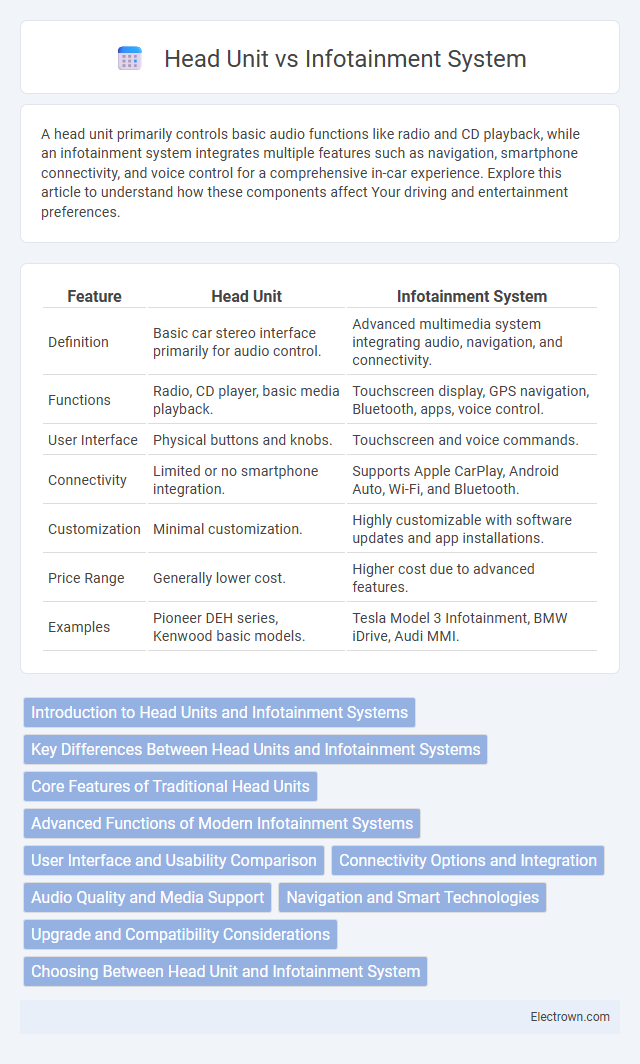A head unit primarily controls basic audio functions like radio and CD playback, while an infotainment system integrates multiple features such as navigation, smartphone connectivity, and voice control for a comprehensive in-car experience. Explore this article to understand how these components affect Your driving and entertainment preferences.
Table of Comparison
| Feature | Head Unit | Infotainment System |
|---|---|---|
| Definition | Basic car stereo interface primarily for audio control. | Advanced multimedia system integrating audio, navigation, and connectivity. |
| Functions | Radio, CD player, basic media playback. | Touchscreen display, GPS navigation, Bluetooth, apps, voice control. |
| User Interface | Physical buttons and knobs. | Touchscreen and voice commands. |
| Connectivity | Limited or no smartphone integration. | Supports Apple CarPlay, Android Auto, Wi-Fi, and Bluetooth. |
| Customization | Minimal customization. | Highly customizable with software updates and app installations. |
| Price Range | Generally lower cost. | Higher cost due to advanced features. |
| Examples | Pioneer DEH series, Kenwood basic models. | Tesla Model 3 Infotainment, BMW iDrive, Audi MMI. |
Introduction to Head Units and Infotainment Systems
Head units serve as the central control device for vehicle audio systems, managing radio, CD, or auxiliary inputs while often featuring a simple display interface. Infotainment systems integrate multimedia, navigation, connectivity, and vehicle settings into a touchscreen interface, offering advanced features such as smartphone integration and voice control. The evolution from basic head units to comprehensive infotainment systems reflects the automotive industry's push towards enhanced user experience and in-car connectivity.
Key Differences Between Head Units and Infotainment Systems
Head units primarily serve as the central control device for audio functions in a vehicle, focusing on radio, CD playback, and basic media inputs. Infotainment systems integrate advanced features such as touchscreen displays, navigation, smartphone connectivity, voice commands, and vehicle diagnostics, offering a more comprehensive multimedia and information experience. Understanding these key differences helps you choose the right system for enhanced in-car entertainment and connectivity.
Core Features of Traditional Head Units
Traditional head units primarily offer essential audio functions such as radio tuning, CD or media playback, and basic volume control. These devices are designed for straightforward user interaction, focusing on delivering clear sound output and simple connectivity options like auxiliary inputs and USB ports. Your vehicle's head unit serves as the central control panel for these core entertainment features without the advanced touchscreen interfaces or integrated apps found in infotainment systems.
Advanced Functions of Modern Infotainment Systems
Modern infotainment systems integrate advanced functions such as voice recognition, smartphone integration through Apple CarPlay and Android Auto, and real-time navigation with live traffic updates. These systems often feature customizable user interfaces, multi-touch displays, and seamless connectivity with vehicle sensors for enhanced safety and convenience. Unlike traditional head units, infotainment systems provide a comprehensive digital experience that combines entertainment, communication, and vehicle control in one platform.
User Interface and Usability Comparison
The head unit primarily functions as the central control for audio and basic vehicle settings with a straightforward user interface designed for quick access and minimal distraction. Infotainment systems offer a more advanced and customizable interface, integrating smartphone connectivity, navigation, and voice control to enhance usability and provide a seamless multimedia experience. Your choice depends on whether you prioritize simplicity and ease of use or a richer, more interactive interface for in-car entertainment and connectivity.
Connectivity Options and Integration
The head unit primarily manages audio playback and basic connectivity options like Bluetooth and USB ports, allowing you to control music and phone calls. Infotainment systems offer advanced integration with smartphones via Apple CarPlay and Android Auto, enhanced touchscreen interfaces, and seamless access to navigation, apps, and voice commands. Your choice impacts how easily your smartphone interfaces with your vehicle's technology for a connected driving experience.
Audio Quality and Media Support
Head units primarily focus on basic audio quality and support for standard media formats like radio, CD, and auxiliary inputs, often offering limited sound processing capabilities. Infotainment systems integrate advanced audio technologies, including surround sound enhancement and high-resolution audio playback, supporting a wide array of media sources such as Bluetooth, USB, streaming services, and smartphone integration. Enhanced digital signal processing (DSP) in infotainment systems significantly improves audio clarity and customization options compared to traditional head units.
Navigation and Smart Technologies
A head unit primarily serves as the central control for audio and basic vehicle functions, often including GPS navigation with straightforward mapping and route guidance. Infotainment systems expand this capability by integrating smart technologies such as real-time traffic updates, voice recognition, smartphone connectivity, and app support, enhancing navigation accuracy and user interaction. Your driving experience benefits from the seamless connection between advanced navigation tools and smart features found in modern infotainment systems.
Upgrade and Compatibility Considerations
When upgrading your vehicle's head unit or infotainment system, compatibility with existing wiring, screen size, and software integration is crucial to ensure seamless functionality. Infotainment systems often offer advanced features like navigation, voice control, and smartphone connectivity, but may require specific hardware support and firmware updates for optimal performance. Evaluating factors such as screen interface, audio output compatibility, and Bluetooth or Apple CarPlay/Android Auto support helps you choose an upgrade that enhances your driving experience without technical conflicts.
Choosing Between Head Unit and Infotainment System
Choosing between a head unit and an infotainment system depends on your vehicle's compatibility and desired features. A head unit primarily manages audio functions and basic navigation, while an infotainment system offers integrated apps, touchscreens, and smartphone connectivity like Apple CarPlay or Android Auto. Your decision should consider ease of installation, user interface preferences, and the level of technology integration needed for a seamless driving experience.
Head unit vs Infotainment system Infographic

 electrown.com
electrown.com